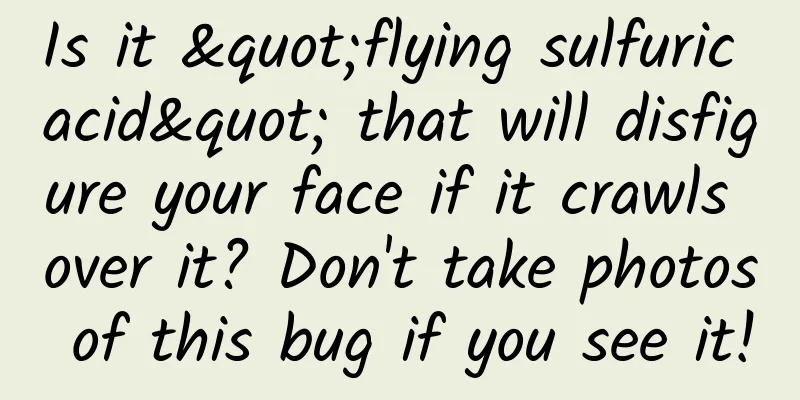Is it "flying sulfuric acid" that will disfigure your face if it crawls over it? Don't take photos of this bug if you see it!

|
Author: Han Zaiming, Assistant Researcher, School of Life Sciences, Tsinghua University Reviewer: Yin Haisheng, Senior Engineer, Researcher-level, Shanghai Insect Museum, Chinese Academy of Sciences gossip With the arrival of summer, everything comes to life, and insects also enter their peak period of activity. At this time, there will be a lot of news with particularly scary headlines on the Internet or other media: "If you encounter this kind of insect, don't slap it to death! Otherwise, the consequences may be very serious", "This insect is too dangerous, they are 'flying sulfuric acid'", "A guy slapped the insect to death and almost got disfigured", etc. Clicking in to check, I found that it was all related to a small insect - the rove beetle. So what exactly is the rove beetle? Can it really not be slapped? Some people say that improper handling will cause disfigurement? Are these claims true? analyze If you encounter a rove beetle, do not slap it. Rove beetles contain rove beetle toxins, which can cause an inflammatory reaction in the human epidermis, possibly causing redness, swelling, and blisters. For people with special physical conditions, it may also leave scars. If it happens on the face, there is indeed a certain risk. However, there are often many exaggerations in online communications. Many pictures have nothing to do with rove beetles. For example, in a widely circulated photo, a person's entire arm is covered with huge blisters. This kind of reaction is not something that a small rove beetle can cause. There are also online rumors that rove beetles will disfigure the face if they crawl over it. These are all rumors, so don't believe them. There are more than 60,000 species of rove beetles? What exactly are rove beetles? Rove beetles are a type of insect belonging to the family Roveidae in the order Coleoptera, which is a general term for more than 60,000 insects in this family. Coleoptera is the largest order in the class Insecta, accounting for nearly one-third of all insect species, commonly known as beetles. That is to say, rove beetles are a type of beetle, just like the familiar scarab beetles and seven-spotted ladybugs. It's just that this beetle doesn't look typical. In our impression, beetles have hard "elytra" protecting their backs, and their entire bodies look like they're wearing a piece of armor, making them look fully armed and extremely solid. Rove beetles are different. Their elytra are very short, covering only the thorax, while their soft abdomen is exposed. At first glance, they don't seem to have obvious wings, hence the name "rove beetles." Don't be fooled by their small wings. Under the elytra of the rove beetle are folded insect membranous wings, and they can also use this pair of membranous wings to fly and move. But relatively speaking, rove beetles prefer to crawl rather than fly laboriously over short distances. There are many kinds of insects. I just mentioned that there are more than 60,000 species of rove beetles in the world, which may be very frightening. In fact, it does not mean that all insects in the family Rove Beetle are poisonous. Only a small number of species in the genus Rove Beetle under the family Rove Beetle are poisonous, and the vast majority of rove beetles are harmless to humans. How do we distinguish poisonous rove beetles? The rove beetles we talk about in daily reports generally refer to poisonous rove beetles. So how do we distinguish poisonous rove beetles? Poisonous rove beetles are generally small in size, usually 1 to 2 cm in length, and have a very distinctive color distribution on their bodies: black head, red chest, black elytra, red front end of abdomen, and black end of abdomen. The whole body presents a distinct "black-red-black-red-black" color, which is very eye-catching. Copyrighted stock images, no reproduction is authorized This kind of very conspicuous color is called warning color, which tells predators: I am poisonous! Don't touch me! I am not easy to mess with! The warning of poisonous rove beetles is very effective. Many non-toxic rove beetles or other insects will also grow similar color patterns on their bodies, trying to fool their natural enemies into thinking they are poisonous and avoid being eaten. In biology, this behavior of a non-toxic (or harmless) species imitating another toxic (or harmful) species to protect itself is called Batesian mimicry, which is a very classic case. In many cases, these mimicry masters imitate vividly, and it can be said that they are indistinguishable from the real thing. For ordinary people like us, it is really not easy to distinguish between the "real and fake Monkey King". In fact, for the sake of insurance, we just stay away from insects with warning colors and don't provoke them, which naturally reduces the danger to ourselves. The poisonous rove beetle How could it be that it cannot produce toxins itself? We have been talking about rove beetles and poisonous rove beetles for a long time, so how do they produce toxins? (Unless otherwise specified, the rove beetles mentioned below generally refer to poisonous rove beetles.) Let me tell you a little-known fact that many people may find hard to believe: rove beetles themselves are not toxic and do not produce toxins. There is a type of bacteria called Pseudomonas symbiotic in the blood (insecticons call it hemolymph), and the toxins of rove beetles are actually secreted by these bacteria. Rove beetles also have different toxicity due to different symbiotic bacteria. It is generally believed that only female rove beetles have strong toxicity, while males are generally weaker or even non-toxic. The difference in toxicity between male and female rove beetles can be more than 10 times, but the possibility that male rove beetles have stronger toxicity cannot be completely ruled out. In fact, it is not uncommon in nature for insects to gain special survival abilities through symbiosis with microorganisms. For example, termites cannot digest the cellulose in wood by themselves, but rely on symbiotic microorganisms in their intestines to help digest and decompose, thus gaining the ability to chew rotten wood. The toxic substance in the blood of rove beetles is a class of chemicals called pederin. Pederin is an amide substance with two tetrahydropyran rings. It is extremely toxic. For humans, its LD50 (median lethal dose, a commonly used research concept in medicine and toxicology, that is, the dose of a poison that can cause half of the deaths in a group of experimental organisms) is even lower than 2 mg/kg. In the body, rove beetle toxins can inhibit the synthesis of proteins and DNA, thereby inhibiting the mitosis of normal cells, which may cause serious damage to internal organs and even lead to death. Copyrighted stock images, no reproduction is authorized If you encounter a rove beetle, don't hit it! Why do we rarely hear news about rove beetle toxins causing death? In fact, there is no need to panic. The above phenomenon is the result of laboratory consumption or intravenous injection. Rove beetles do not bite or sting people like poisonous snakes and mosquitoes, nor do they sting people like wasps and scorpions. They cannot inject rove beetle toxins into our bodies, so it will not cause such terrible consequences. As mentioned above, the toxin of rove beetles is in their blood. As long as the body of the rove beetle is not damaged and the blood does not flow out, it will not cause any harm to the human body. The injuries of rove beetles encountered in daily life are often the result of rove beetles being slapped to death while crawling on the body, and the body ruptures and blood flows onto the skin. This is why we have to emphasize again and again that you must not slap rove beetles when you encounter them. Why do rove beetles seek out humans? Why does the rove beetle have to crawl on people when there is nothing else to do? Actually, the rove beetle is also quite wronged. The rove beetle crawls on your body because it does not regard you as a human. (This is not an insult!) The rove beetle is not a living creature that lives with humans. It is not like flies and cockroaches that like to eat leftovers or garbage dumps in people's homes; the rove beetle does not need to suck human blood to supplement nutrition like mosquitoes and bedbugs. It does not need humans to live at all. It can be said that it has nothing to do with humans. It is purely accidental to appear on people's bodies. Of course, there is also a point that rove beetles are phototactic and are easily attracted to human lights at night. If the indoor lights are bright and the doors and windows are open at night, rove beetles may be attracted to the house. Rove beetles are not good at flying and usually crawl. The size of humans is too different from that of rove beetles. They never thought that this huge object like a mountain could move. They just treated humans as ordinary objects and crawled over them. So in fact, the relationship between us and the rove beetle is one of "I won't offend others unless they offend me". After all, if it is flattened by someone, it will be smashed to pieces, and there is no benefit for both sides. Once you come into contact with the blood of a rove beetle, it will indeed lead to a series of consequences if not handled in time. The rove beetle toxin introduced earlier will cause a unique form of irritation after contact with the skin, which is a type of contact dermatitis. Note that rove beetle toxin is not acid, and its stimulation mechanism is not acidic corrosion or the dehydration effect of concentrated sulfuric acid. Therefore, some media say that rove beetles are flying "sulfuric acid" which is exaggerated and biased. However, the effect of rove beetle toxin should not be underestimated. If it causes rove beetle dermatitis, it can cause skin erythematous bullous lesions. If it lasts for a long time, it may also cause other symptoms such as fever, edema, neuralgia, joint pain and vomiting. Copyrighted stock images, no reproduction is authorized Then we encounter rove beetles What should I do? First of all, don't panic when you encounter a rove beetle. First observe the place where the rove beetle appears. If it is outdoors and there are no people nearby, just avoid it and stay away from it. Rove beetles don't like to get too close to people. This is the safest approach. If rove beetles appear indoors or in crowded places, or even when you find them on your body, be careful. You can put a piece of paper (or a leaf or other object) in front of their crawling path, wait for them to crawl onto the paper, and then move them away with the paper. Indoors are not the living environment for rove beetles, so the safest way is to move them outdoors, away from crowds, so they will not be harmed. There are reports that you can blow away the rove beetle on your body or carefully brush it off with a brush, but this is not recommended. First of all, it is difficult to control the direction and strength when blowing it away, and it may blow it onto other people; brushing it away is even more difficult. Ordinary people don’t know enough about rove beetles, so it is difficult to control the strength. If you accidentally damage the body of the rove beetle, it will be more harm than good. Therefore, the safest way is to let it slowly crawl away without disturbing the rove beetle. Let me emphasize again, if you encounter a rove beetle, do not slap it to death or step on it, even if it is not on you. The splashing of blood during the slapping process or unintentional contamination may cause the blood of the rove beetle to get on your skin, causing unnecessary skin inflammation. When dealing with rove beetles, we do not harm them, and they will not harm us. If you accidentally kill a rove beetle on your skin, you must rinse the contacted skin with plenty of running water. Do not rub the contacted skin with your hands or other exposed skin, and never touch your eyes, mucous membranes, etc. with your hands that have killed a rove beetle. If you find redness and swelling on your skin, you should seek medical attention immediately. The doctor will prescribe a lot of drugs to relieve the symptoms according to the situation. The magic of nature lies in the colorful life. The terrible rove beetle toxin can also be a double-edged sword, because it has the function of inhibiting DNA replication and protein synthesis. It is also a potential new drug with anti-tumor and antiviral properties. There are many medical studies on rove beetle toxins underway. Perhaps in the near future we will be able to obtain new anti-cancer drugs developed based on rove beetle toxins. in conclusion Among the more than 60,000 species of rove beetles, we only need to worry about the poisonous rove beetles, which have a very obvious "black-red-black-red-black" warning color. The poisonous rove beetles themselves cannot produce toxins, but the toxins are produced by a type of Pseudomonas symbiotic in the hemolymph of the rove beetles. The poison of the poisonous rove beetles is in the blood, and the venom cannot be injected through bites. Rove beetles do not like humans and will not specifically attack humans. If a rove beetle accidentally crawls onto your body, remember not to hit it. Instead, place a piece of paper in the path of the rove beetle, and wait for the rove beetle to climb onto the paper, then gently move it away. If you really kill a rove beetle on human skin, be sure to rinse the contact area with plenty of running water. Do not rub the contact area with your hands or other exposed skin. And never touch your eyes, mucous membranes, etc. with your hands that have killed a rove beetle. The article is jointly produced by Science Rumor Refutation x Fanpu. Please indicate the source when reprinting. The cover image and images within this article are from the copyright gallery. Reprinting and quoting them may lead to copyright disputes. |
>>: Why is lotus recognized as the center of summer flowers?
Recommend
Meizu App Store information flow advertising promotion, the delivery material requirements are standardized!
Meizu information flow map Material format: JPG /...
A 7.1-magnitude earthquake hit Xinjiang late at night! How to avoid risks and save yourself and prevent aftershocks scientifically?
The China Earthquake Networks Center officially d...
High-level training techniques for both sexes: Creating a perfect husband starts with "talking well"
In a relationship, quarrels and anger are always ...
Like! Primary school students appreciate flowers and make merit! If you see this plant, please call the police immediately
Recently, three primary school students in Ninggu...
iPhone 11 review: Mediocre? No problem, it will still be a hot seller!
In the pursuit of mediocrity, Apple's iPhone ...
Fei Fan: Douyin live streaming sales boom operation growth training camp, teach you how to play live streaming sales
Fei Fan: Douyin live streaming sales boom operati...
What is Baidu Domination? Let me teach you how to get on the homepage with Baidu Domination.
What is Baidu Domination? Let me teach you how to...
How do To B companies do marketing promotion?
Before answering this question, there is actually...
From CTR 0.5% to CTR 7%, share 3 great promotion ideas!
A few days ago, I wrote an article about informat...
Jinan Mini Program Franchise Company, how much does it cost to join a points mini program?
How much does it cost to join the Jinan Points Mi...
1G bandwidth app server rental and hosting?
1G bandwidth app server rental and hosting? In th...
What is bidding hosting?
The so-called bidding hosting mainly refers to th...
2022 Shenzhen official announced the latest notice on the unblocking time: Can it be unblocked on the 20th?
Due to the complexity of the local epidemic in She...
“Street stall economy” brand leverages marketing and copywriting!
The way people greet each other these days has ch...









